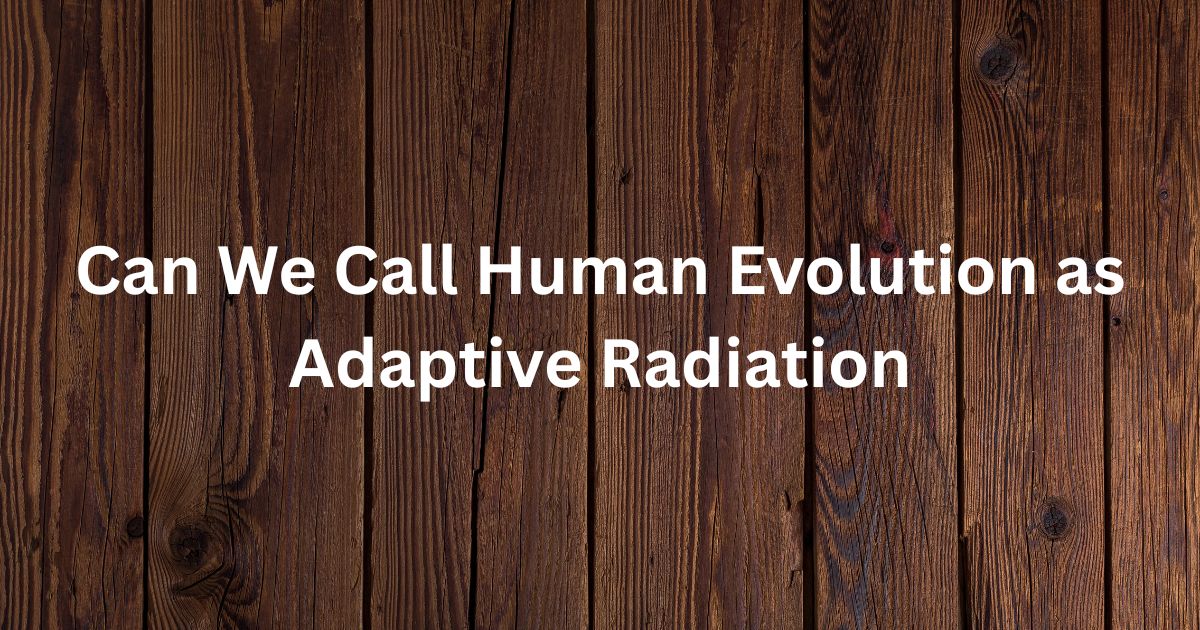Human evolution is one of the most extensively studied and debated topics in biological anthropology and evolutionary biology. It traces the lineage of Homo sapiens from earlier hominins, documenting changes in anatomy, behavior, culture, and cognition. A fascinating question that arises in this context is: Can we call human evolution as adaptive radiation?
This article aims to unpack this question by exploring the concepts of adaptive radiation, evolutionary theory, and hominin diversification, and by evaluating whether the human evolutionary process aligns with the key characteristics of adaptive radiation. Through this analysis, we will also consider counterarguments and broader evolutionary implications.
What Is Adaptive Radiation?
Adaptive radiation is an evolutionary process in which a single ancestral species rapidly diversifies into multiple distinct species, each adapted to exploit different ecological niches. This phenomenon typically occurs under specific circumstances:
- Availability of unoccupied niches (e.g., after mass extinction or colonization of a new habitat)
- Rapid speciation
- Phenotypic diversification (morphological, physiological, or behavioral differences)
- Common ancestry of the diversified species
Classic examples of adaptive radiation include:
- Darwin’s finches in the Galápagos Islands
- Cichlid fishes in African lakes
- Mammalian radiation after the extinction of dinosaurs
Let us now apply these characteristics to human evolution to assess whether it qualifies as adaptive radiation.
The Course of Human Evolution
From Common Ancestors to Homo Sapiens
The story of human evolution begins about 6–7 million years ago, when our lineage diverged from that of our closest living relatives—the chimpanzees. Since then, numerous hominin species have emerged, including:
- Australopithecus afarensis
- Paranthropus boisei
- Homo habilis
- Homo erectus
- Homo neanderthalensis
- Homo sapiens (modern humans)
These species displayed considerable differences in skull structure, brain size, locomotion, diet, and tool use. The evolutionary pathway was not linear but rather branching, with many lineages coexisting and sometimes interbreeding.
Evaluating Human Evolution Against the Criteria of Adaptive Radiation
Let’s assess human evolution based on the four key criteria of adaptive radiation.
1. Common Ancestry
Human evolution clearly fits this criterion. All hominins evolved from a common ancestor, likely an ape-like primate living in Africa around 6–7 million years ago. This establishes a shared phylogenetic lineage.
Verdict: Yes
2. Rapid Speciation
Adaptive radiation often involves rapid emergence of multiple species over a short geological timescale. In human evolution, while there was significant diversification, the process occurred over millions of years, not in rapid bursts.
However, between 2.5 to 1 million years ago, several hominin species appeared, such as Homo habilis, Homo rudolfensis, Homo ergaster, and Paranthropus spp., which could be interpreted as a mild adaptive radiation event.
But compared to classic adaptive radiation models, human speciation has been relatively gradual, with fewer lineages and slower diversification rates.
Verdict: Partially
3. Ecological Niche Differentiation
One of the strongest criteria for adaptive radiation is the occupation of diverse ecological niches by the descendants. Darwin’s finches, for example, evolved various beak shapes adapted to specific food sources.
In hominin evolution, ecological differentiation was evident in terms of:
- Dietary strategies: from fruit and leaves (Australopithecus) to meat consumption and cooking (Homo erectus, Homo sapiens)
- Habitat use: from forests to savannas and later to various global environments
- Technological adaptation: use of tools, fire, and clothing allowed occupation of colder and drier environments
While these changes reflect ecological adaptability, they often occurred within a single species, particularly Homo sapiens, rather than multiple species each occupying different niches at the same time.
Verdict: To some extent, but not strongly diversified across simultaneous lineages
4. Phenotypic Diversification
Human ancestors show clear morphological and behavioral diversification:
- Paranthropus species developed large jaws and teeth for tough vegetation.
- Homo erectus had a larger brain and developed early stone tools.
- Neanderthals adapted to cold climates with robust bodies and complex tools.
- Homo sapiens evolved advanced cognition, language, and symbolic thought.
This diversity supports the concept of phenotypic divergence, even if not as starkly niche-specific as seen in classic adaptive radiation.
Verdict: Yes
Counterarguments: Why Human Evolution May Not Be Adaptive Radiation
While human evolution shares some features with adaptive radiation, several counterpoints challenge the classification:
1. Limited Number of Species
Adaptive radiation usually produces dozens or hundreds of species. In the hominin lineage, only a handful of species evolved over several million years.
2. Extinction vs. Coexistence
Many hominin species were successive, not coexisting. In adaptive radiation, multiple species typically coexist by occupying different niches.
3. Dominance of Homo Sapiens
Homo sapiens eventually outcompeted or absorbed other hominins, leading to a single dominant lineage, which contrasts with the sustained diversity seen in true adaptive radiations.
4. Cultural vs. Biological Adaptation
Much of human ecological versatility comes from cultural evolution (e.g., tools, shelter, clothing), rather than biological speciation. This sets humans apart from other species undergoing adaptive radiation via physical traits.
Hybrid View: Mini Adaptive Radiations Within Human Evolution
Some scientists suggest that localized, short-term adaptive radiations may have occurred in the broader timeline of human evolution. For instance:
- Australopithecines diversified into Australopithecus and Paranthropus with differing ecological adaptations.
- The Homo lineage diversified into various forms (H. habilis, H. erectus, H. floresiensis, H. naledi), each with unique traits and geographies.
These could be viewed as micro-radiation events, although not as extensive or rapid as classic examples.
Broader Evolutionary Perspective
The question also invites a broader interpretation of what constitutes adaptive radiation. If one loosens the criteria to include:
- Behavioral and cultural adaptation
- Extended evolutionary timelines
- Technological niche expansion
Then human evolution could be seen as a unique form of adaptive radiation, where the “niche differentiation” occurred more through cognition and culture than through speciation.
In this light, Homo sapiens alone might represent a culturally driven adaptive radiation, adapting to deserts, tundras, forests, and urban environments using technology rather than biology.
Conclusion
So, can we call human evolution as adaptive radiation? The answer lies somewhere between yes and not quite.
- Yes, because human ancestors shared a common origin, diversified phenotypically, and adapted to varied environments.
- No, because this diversification was slow, involved few species, and much of it was culturally, not biologically, mediated.
Human evolution exhibits some features of adaptive radiation but does not fully meet the classical criteria. Therefore, while it may not be a textbook example of adaptive radiation, it represents a distinct evolutionary pathway that combines biological adaptation with unprecedented cultural evolution.
In summary, human evolution might be better described as an evolutionarily unique case of limited adaptive radiation enhanced by cultural complexity, rather than a classic example like Darwin’s finches or cichlid fishes.










